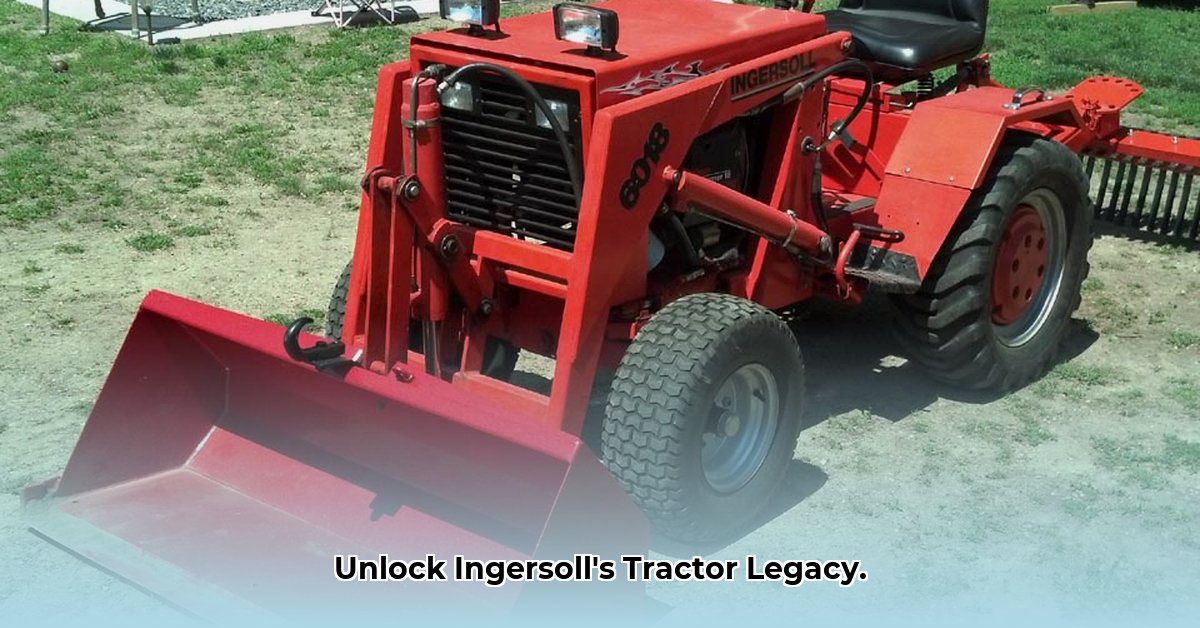
Ingersoll Tractors: A Legacy of Innovation and Reliability
Ingersoll tractors have a rich history, evolving from compact garden workhorses to robust agricultural machines. This guide delves into their development, providing insights for both enthusiasts and prospective buyers. We'll explore model variations, maintenance tips, and help you choose the right Ingersoll tractor for your needs. Did you know that the introduction of hydraulic systems fundamentally changed Ingersoll's capabilities? For more on international tractor specs, see this helpful resource: International Tractor Specs.
The Early Years: Compact Powerhouses
Early Ingersoll tractors, many in the 100 series, were known for their compact size and belt-driven power. These were ideal for smaller tasks like tending gardens and lawns. Their straightforward design prioritized efficiency and ease of use. This focus on simplicity laid the foundation for future innovations.
Hydraulics: A Revolutionary Advance
The integration of hydraulic systems marked a pivotal shift. This technology allowed for the creation of much larger and more powerful models, such as the 200, 3000, 400, and 4000 series. Hydraulics significantly broadened the tractor's capabilities, enabling it to handle heavier workloads with greater precision. What impact did this change have on the types of jobs Ingersoll tractors could perform?
Powertrain Options: Customizable Performance
Ingersoll tractors offered a variety of engine options from renowned manufacturers like Kohler, Onan, and Briggs & Stratton. This allowed users to select an engine that matched their power needs and budget. This customization ensured a suitable Ingersoll tractor was available for a wide range of tasks, from light lawn care to demanding agricultural work. How did engine choice affect a tractor's overall performance and suitability for specific jobs?
Big Wheels, Big Impact: Enhanced Traction and Stability
The introduction of the "Big Wheel" design with the 400/4000 series dramatically improved traction, stability, and overall performance, particularly on uneven terrain. This innovation expanded the range of tasks Ingersoll tractors could handle, allowing them to tackle more challenging conditions. What other design elements were likely improved to complement the new, larger tires?
Model Variations: Meeting Evolving Demands
The variations within Ingersoll model lines (like the 3010 and 3020) reflect evolving market demands and component availability. Some models had shorter production runs due to factors such as market trends or parts availability. This constant evolution showcases Ingersoll's commitment to meeting diverse user needs. How did these model variations reflect changes in the marketplace?
Choosing Your Ingersoll Tractor: A Comprehensive Guide
Selecting the ideal Ingersoll tractor requires careful consideration of several factors:
| Factor | Considerations |
|---|---|
| Primary Use | Lawn maintenance? Small-scale farming? Heavy-duty agricultural work? |
| Required Power | Horsepower needed for typical tasks. |
| Hydraulics | Lift capacity and hydraulic flow rate required for attachments. |
| Attachments | Compatibility of attachments with the chosen model. |
| Budget | Set a realistic budget and explore models within that range. |
Thoroughly reviewing model specifications is crucial. Prioritize features that align with your specific needs, budget, and typical usage.
Ingersoll Tractor Maintenance: Essential Tips
Regular maintenance is key to maximizing your Ingersoll tractor's lifespan and performance. Follow these essential steps:
Fluid Checks and Changes: Regularly check and change engine oil, hydraulic fluid, and other fluids according to your owner's manual. This crucial step prevents damage and keeps moving parts lubricated.
Component Inspection: Regularly inspect belts, hoses, and other components for wear and tear. Replace worn parts promptly to avoid malfunctions.
Leak Detection and Repair: Address any leaks immediately. Leaks can indicate more significant problems and reduce efficiency.
Scheduled Maintenance: Adhere to the manufacturer's recommended maintenance schedule, which typically includes tasks like air filter replacement and lubrication. What is the importance of adhering to the manufacturer's maintenance schedule?
Ingersoll's Enduring Legacy: A Look Ahead
Ingersoll's history reflects the evolution of agricultural mechanization. Their adaptability and commitment to quality have contributed to continued success. What future innovations might we expect from Ingersoll tractors? The story continues.
Key Takeaways:
- Ingersoll tractors offer diverse models catering to various needs and budgets.
- Older models often boast better parts availability.
- Newer models may provide increased comfort and safety, but potentially higher repair costs.
- Attachment compatibility varies; verify before purchase.
- Consider primary uses (snow removal, tilling, etc.) when selecting a model.